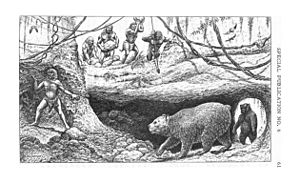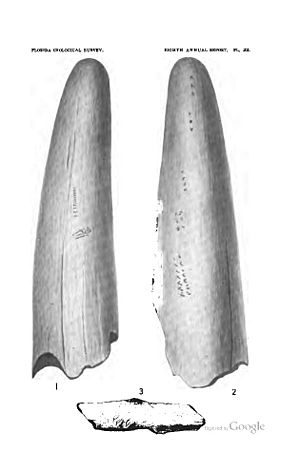Vero man facts for kids
Vero man is the name for a group of ancient human bones. These bones were found near Vero Beach, Florida, in 1915 and 1916. They were discovered alongside bones of animals that lived during the Pleistocene period, also known as the Ice Age. At that time, many scientists debated if humans lived in Florida (or anywhere in the Americas) during the Ice Age. Most archaeologists did not believe the Vero human bones were that old. However, newer studies now show that the Vero human bones are indeed from the Ice Age. This collection is the largest group of Ice Age human remains found in North America.
Discovering Vero Man
In late 1913, workers building a drainage canal near the Indian River started finding vertebrate fossils. These fossils were from animals. Isaac M. Weills and Frank Ayers sent samples to Florida's state geologist, E. H. Sellards. He quickly realized these were bones from Ice Age animals.
Early Finds and Debates
In 1915, 26 fossilized human bones and pieces were found in the canal banks. The next year, Sellards dug at the site himself. He found a mammoth tusk with carvings and a bird bone with possible human marks. He also found human bones in the same layer of earth as the Ice Age animal fossils. Sellards also uncovered sharp chert flakes and tools made from bone. He even found a broken spear point and some ceramic pieces near the surface.
Sellards shared his findings in 1916. He invited other scientists to visit the Vero site in 1916 and 1917. Scientists like Aleš Hrdlička, T. Wayland Vaughan, Oliver Perry Hay, George Grant MacCurdy, and Rollin T. Chamberlin came to look. Sellards and Hay believed the human bones were from the Ice Age. But Hrdlička, MacCurdy, and Chamberlin thought the bones were much more recent. Vaughan felt more proof was needed. Hrdlička was a very important anthropologist then. He strongly believed humans arrived in America long after the Ice Age ended.
Other places in Florida have also found human bones or tools with Ice Age animal remains. These include the nearby Helen Blazes and Melbourne Bone Bed sites.
Recent Discoveries and Studies
The human bones Sellards dug up were studied by many groups over the years. About 35 years after Vero man was found, carbon-14 dating became possible. This method helps find the age of fossils. However, some of the Vero bones were lost. Others could not be tested because they had been preserved with chemicals.
In 2009, scientists announced an exciting find. They discovered a carving of a mammoth, mastodon, or possibly a giant sloth. This carving was on a bone found north of Vero Beach. It might be one of the oldest pieces of art found in the Americas. Scientists noticed it looked similar to Ice Age art from Europe. Art historian Barbara Olins Alpert noted that looking similar does not always mean they are connected. Realistic art styles can appear in different places and times.
In 2014, new digs began at the Vero man site. Mercyhurst University and a local group called the Old Vero Ice Age Sites Committee led these efforts. The committee announced they found a possible "human living surface" that is at least 12,000 years old. Digging continued in 2015. Recent finds include 14,000-year-old burned bones from a dire wolf and a horse. These might have come from an ancient hearth or campfire. The archaeologists from Mercyhurst University stopped working at the site after 2015. Since 2016, archaeologists from Florida Atlantic University have joined the Old Vero Man site excavations.



